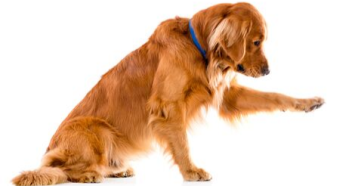
All three of my dogs are certified therapy dogs and most of our visits are to the elderly in retirement and nursing homes or hospice. It’s vitally important my dogs do not paw or scratch the people we visit as the dogs could rip fragile skin.
The elderly are not the only people who can be hurt by a dog who uses his paws to gain attention. Babies and toddlers can easily be hurt by an eager paw; even hale and hearty people can be scratched. Any dog who has learned that pawing at people can result in a desired prize – attention, treats, or toys – can scratch skin or ruin clothes.
Dogs Paw Because it Works
Dogs repeat actions when those actions gain the dog a desired response. In other words; it works to the dog’s benefit. Let’s look at this scenario: Your dog is snuggled up to you on the sofa while you’re reading. Your dog wants some attention so he paws at your arm. Not even thinking about it, you reach down and rub behind your dog’s ears or give him a tummy rub. When you stop, he paws you again and, absentmindedly, you repeat the petting. The pawing gained your dog attention; exactly what he wanted.
The same thing probably happens when your dog wants a bit of the food someone is eating. He paws at grandma’s knee and grandma gives him a piece of food. Again, the pawing worked.
A habit such as this one usually starts small and grows. Perhaps the first time the pawing was accidental; the dog reached out with a paw and something good happened. That could have been an ‘Ah ha!’ moment for your dog.
Does Your Dog Know Shake?
If your dog has a problem pawing people, why would you want him to shake paw to hand with you? It may seem like this would make the behavior worse, but what it actually does is bring attention to the action. Once your dog is aware of what he’s doing, and can do it when you ask him to, then it’s easier to discourage the action.
Many dog owners teach their dogs to shake; it’s often one of the first tricks a dog learns. If your dog knows shake, practice it until your dog is doing it well every time you ask.
If your dog doesn’t know shake, then teach it. Hold your hand out to your dog, fairly low, right in front of one of his paws. Don’t do anything else and don’t say anything. If he noses your hand, don’t do anything. When he lifts or even moves a paw, praise him and give him a treat. Repeat a few times and take a break. Gradually, over several days, praise him when his paw gets closer and closer to your hand. When he finally puts his paw in your hand, give him a jackpot reward of praise, petting, and treats. In future training sessions, add the word ‘shake’ to his action of moving his paw to your hand.
Now teach your dog that the only time you will respond or reward his pawing actions is when you ask for it. If he paws when you haven’t asked, don’t respond. Don’t even say ‘no’ as that is still a response (attention) from you. You can also move your arm away from him or have him move away from you.
You can continue to practice the shake as a trick. Just make sure you respond and reward it only when you ask for it.
Work His Brain and Body
Pawing is usually an attention getting action on your dog’s part, so teach some other actions that can get him the attention he desires. Play retrieving games with him and praise him each time he brings back the toy. Playing with your dog is wonderful for your shared relationship, plus it gives your dog some exercise at the same time.
If your dog hasn’t attended a basic obedience class, enroll in one. Not only will this help build your communication and training skills, but your dog will also learn some self-control. A group class also provides distractions from other people and dogs. When your dog can focus on you amidst these distractions, he can do anything. If your dog has been to a class, perhaps a training tune-up is in order.
If your dog knows the basic exercises sit and down, do puppy push-ups as these work both his body (doing pushups can be hard work) and his brain (he has to think about what he’s doing).
Trick training is also great fun that uses your training and communication skills and increases your dog’s focus. Teach the spin command as well as shake. If those are too easy, or if you really want a challenge, teach your dog his A, B, and Cs.
It’s important to keep your dog’s mind and body both busy and challenged on a daily basis, but it’s even more important when trying to change an unwanted behavior.
Be Consistent
As with all training and behavior modification efforts, being consistent is vital. If you reward your dog sometimes when he paws you and don’t react other times, he’s going to keep trying to get a response.
This includes other family members, guests, and friends. Everyone must be on board with this change, otherwise your dog will continue to paw other people with the potential of causing harm.